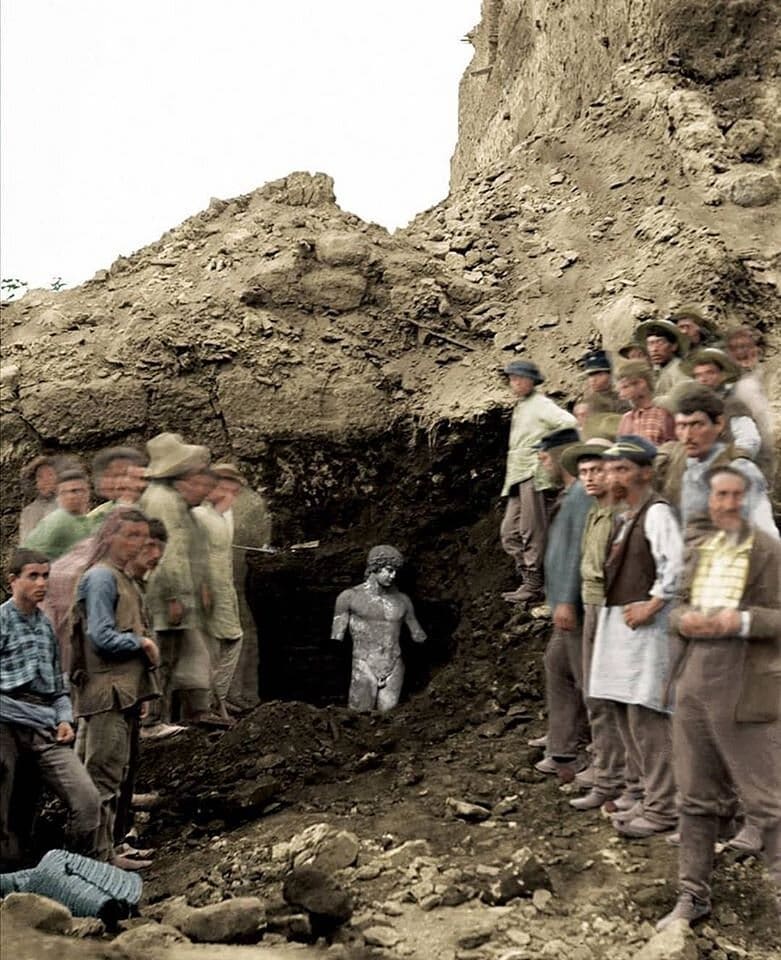In 1894, a significant archaeological discovery took place at Delphi, Greece—a finding that captured the imagination of historians and art enthusiasts alike: the unearthing of the Statue of Antinous. This magnificent piece of art is a tribute to Antinous, the cherished companion of Roman Emperor Hadrian. Renowned for its breathtaking portrayal of youthful beauty and divine idealism, the statue is more than just an artistic masterpiece. It embodies the Roman admiration for Antinous and showcases the profound influence of Greek artistic traditions on Roman sculpture.
The rediscovery of this statue at Delphi offers a glimpse into the ancient world’s values, where art served as a powerful medium to express emotion, honor relationships, and immortalize beauty. Through its craftsmanship and cultural significance, the Statue of Antinous remains a vital artifact that bridges two great civilizations—Greece and Rome—revealing their shared appreciation for aesthetics and their intertwined histories.

Antinous’s story is one of love, loss, and legacy. His untimely death in 130 AD marked a pivotal moment in the life of Emperor Hadrian. Overcome with grief, Hadrian deified Antinous, transforming him into a symbol of eternal youth, divine love, and idealized beauty. Across the Roman Empire, statues and monuments were erected to honor him, solidifying his place as a god in Roman culture. The Statue of Antinous at Delphi is among the most renowned of these depictions. With its lifelike features and graceful form, the statue exudes an aura of serenity and timeless elegance, encapsulating the essence of Antinous as both a divine figure and a cherished companion.
What makes the Statue of Antinous particularly remarkable is its ability to seamlessly blend Greek and Roman artistic traditions. The Romans, known for their skill in portraiture and realism, often turned to Greek art for inspiration when crafting idealized figures. Greek art, celebrated for its focus on harmony, proportion, and physical perfection, deeply influenced Roman sculptors. The Statue of Antinous exemplifies this fusion. Its meticulous attention to detail, flawless anatomical precision, and ethereal beauty reflect the ideals cherished by both Greek and Roman societies. This harmonious blending of styles is a testament to the cultural exchange between the two civilizations, highlighting how Greek aesthetics shaped Roman artistic expression.
The discovery of the statue at Delphi not only reaffirmed the deep artistic connections between Greece and Rome but also shed light on the enduring legacy of Antinous and Hadrian. Their bond transcended the norms of their time, leaving behind a story that continues to inspire and intrigue modern audiences. For Hadrian, Antinous was more than a companion—he was a muse, a source of divine inspiration whose memory he immortalized in stone. The statue serves as a poignant reminder of their unique relationship, a connection that defied societal conventions and resonated with themes of love and devotion.
Today, the Statue of Antinous holds a prominent place in the Delphi Archaeological Museum, where it continues to captivate visitors from around the world. Standing as a symbol of beauty, youth, and divine love, the statue draws attention to the rich cultural tapestry of the ancient world. Its presence in the museum invites reflection on the values of antiquity, where art was not just an expression of creativity but a means of preserving emotional and cultural narratives.
The rediscovery of this masterpiece in 1894 marked a turning point in the modern understanding of ancient art. The statue’s unveiling reminded the world of the emotional depth and cultural significance encapsulated in such works. It is not merely a representation of a young man’s beauty but a testament to the ideals of an era that celebrated harmony, love, and the human form. For scholars, the statue provides valuable insights into the artistic techniques and cultural values of the time. For art lovers, it offers a timeless glimpse into the genius of ancient sculptors who sought to immortalize their subjects with unparalleled skill and devotion.
The legacy of Antinous and Hadrian is one of resilience and reverence. Their story, immortalized through statues like the one at Delphi, serves as a reminder of the human need to remember and honor those we hold dear. In a world where monuments often symbolize power and conquest, the Statue of Antinous stands apart. It is a deeply personal tribute, reflecting the intimate bond between two individuals whose lives were intertwined in a way that continues to resonate with audiences today.
As one of the finest examples of Greek and Roman artistry, the Statue of Antinous remains a cornerstone of classical sculpture. Its enduring appeal lies not only in its exquisite craftsmanship but also in its ability to evoke universal themes of love, loss, and beauty. The statue’s rediscovery at Delphi is a celebration of these timeless values, offering a glimpse into an ancient world that, despite its distance in time, feels remarkably familiar in its pursuit of art and meaning.
In examining the Statue of Antinous, one cannot help but marvel at the cultural and historical context that produced such a masterpiece. It is a reminder of the interconnectedness of human civilizations and the shared ideals that transcend time and geography. The statue is more than a relic of the past—it is a living testament to the enduring power of art to convey emotion, tell stories, and connect us to the people and cultures that came before us.
Through its lifelike features and idealized form, the Statue of Antinous continues to inspire awe and admiration, standing as a beacon of the ancient world’s artistic and cultural achievements. Its presence in the Delphi Archaeological Museum ensures that the legacy of Antinous and Hadrian remains alive, allowing future generations to appreciate the beauty and significance of this extraordinary work of art.





